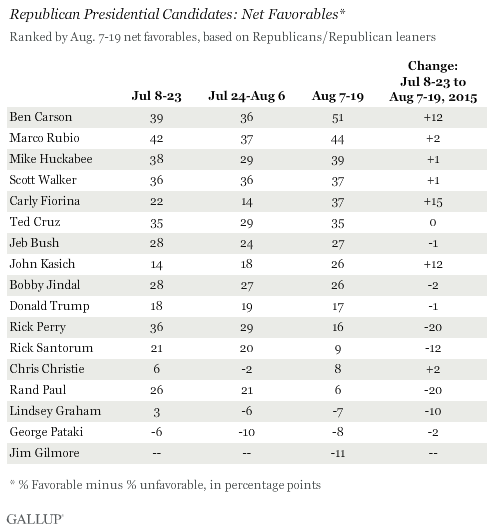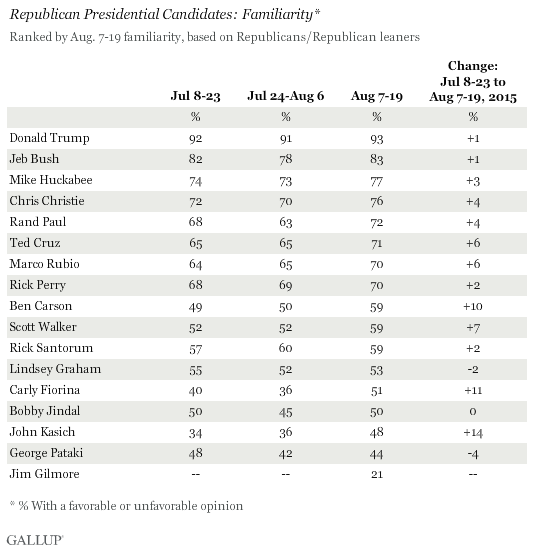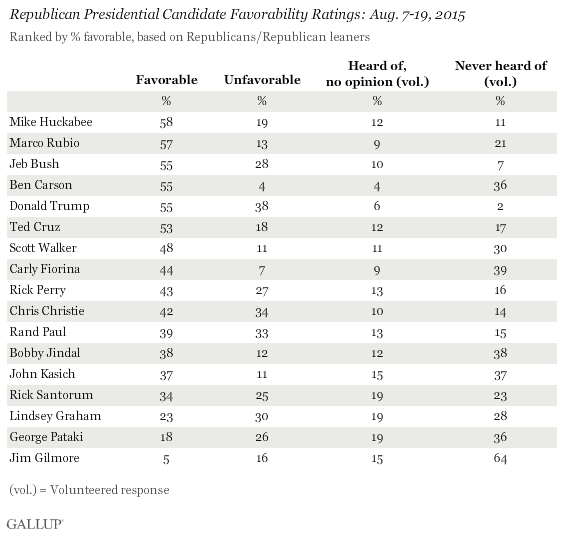Story Highlights
- Net favorable ratings for Fiorina, Carson, Kasich jump up
- Images of Paul and Perry suffer in last two weeks
- Trump's net favorable rating stable
PRINCETON, N.J. -- The net favorable ratings of three Republican presidential candidates -- Carly Fiorina, Ben Carson and John Kasich -- improved significantly among Republicans after the Aug. 6 GOP debates. Rick Perry's and Rand Paul's images took a hit. Donald Trump's ratings have remained remarkably stable over the past six weeks.

For the purposes of this analysis, Gallup's tracking of the images of the declared GOP candidates is split into three periods -- July 8-23, July 24-Aug. 6 and Aug. 7-19 -- with the last period encompassing the 13 days after the first Republican debates. The net favorable ratings displayed in the accompanying table reflect the percentage of Republicans and Republican leaners who have a favorable opinion of each candidate minus the percentage with an unfavorable opinion.
Key findings:
- Fiorina's net favorable rating is up 15 percentage points since July and 23 points from late July/early August, putting her among the top five candidates on this measure in the latest time period.
- Carson's net favorable rating among Republicans and Republican-leaning independents was already high in the July period, but with a 12-point gain, the physician and former neurosurgeon now has the highest net favorable of any candidate, at +51.
- Kasich is up 12 points since early July, and has moved from having one of the lowest net favorable ratings to an above-average score.
- Former Texas Gov. Perry's image in July was high enough among Republicans to put him up in the ranks of the best-rated candidates. Now, with the 20-point drop in his image after the debate, he is slightly below average.
- Kentucky Sen. Paul was not in as good a position as Perry when Gallup's tracking began in early July, making it worse for him after his rating suffered a large drop of 20 points after the debate. His downturn puts him in the next-to-lowest group of candidates on this image measure, just below Chris Christie and ahead of only Lindsey Graham, George Pataki and Jim Gilmore, whose images are net negative.
- Paul was in the prime-time Aug. 6 debate, while Perry was relegated to the earlier, less-highly watched debate. But both men lost considerable ground in the weeks afterward, suggesting it didn't matter which debate they were in. Fiorina, whose image improved significantly, was also in the earlier debate.
- Marco Rubio, Mike Huckabee, Scott Walker and Ted Cruz join Carson and Fiorina as having the most positive images among the 17 candidates -- but none of these four saw much change in their images after the debates.
- Graham and Rick Santorum each lost at least 10 points between July and the post-debate period.
- Trump's image among Republicans, despite the media's extensive coverage of his candidacy and his many controversial comments, has remained remarkably constant across this period. His net favorable rating is slightly below the average of the 17 candidates, similar to Perry's score.
Kasich, Fiorina and Carson Have Become More Well-Known
Kasich, Fiorina and Carson, in that order, had the largest gains in familiarity -- the percentage of Americans who have formed either a positive or a negative opinion of each -- between July and the post-debate period. Walker and Cruz also saw their familiarity scores rise modestly, though their net favorable scores did not improve in the process. Trump, Jeb Bush, Huckabee and Christie are the best-known candidates, and Gilmore, Pataki and Kasich the least known.

Despite their jump in familiarity, Kasich, Fiorina and Carson are not in the ranks of those most well-known among Republicans. Notably, only Pataki and Gilmore are less well-known than Kasich. Familiarity scores for Paul and Perry went up slightly, even as their net favorable scores plummeted.
Former Virginia Gov. Gilmore, who left office in 2002, mounted a short-lived campaign for president in 2007 and ran a losing campaign for U.S. senator in 2008, announced his presidential candidacy on July 29. He faces by far the biggest name identification challenge of any of the candidates. Only 21% of Republicans nationwide know enough about him to have an opinion.
Implications
A number of GOP presidential candidates who are well-liked face the challenge of becoming better known to significant numbers of Republicans who, at this point, do not know them well enough to rate them. These include Carson -- who is still not well-known even with his post-debate gains -- Walker, Fiorina and, to a lesser degree, Rubio and Cruz.
On the other hand, three candidates who are well-known have broad image issues. Trump, despite being hailed as the front-runner based on his standing in GOP horse-race polls, has a net favorable rating of +17 among Republicans, slightly below average, with a 55% favorable rating and a high 38% unfavorable rating. (The complete favorability data are displayed at the bottom of this article.) Bush's net favorable rating -- at +27 -- is a little above average, and Christie's +8 is one of the lowest among the candidates.
Trump's situation is perhaps the most fascinating of any GOP candidate. He has over 90% name identification among Republicans and is the major focus of news coverage and social media discussion about the Republican nomination process. His relatively anemic overall net favorable score results from his having a high unfavorable rating. But the 55% of Republicans who like him is similar to the percentages of Republicans who rate Huckabee, Rubio, Carson, Bush and Cruz favorably. Thus, in terms of the pool of Republicans who like a candidate, Trump is on equal footing with these other individuals.
What Trump's high unfavorable ratings will mean down the line remains to be seen. Trump's upside potential may be more limited than, say, that of Rubio -- who is less well-known but at this point has almost the same favorables as Trump among Republicans, but with a third of the unfavorables. The fact that many Republicans have an unfavorable opinion of Trump is a possible indicator that there are lurking negatives about his candidacy that could spread to other rank-and-file Republicans who now are favorable toward him. Of course, it may also be that those who now have a negative opinion of the business mogul could turn positive as the campaign progresses.
The post-debate jump in familiarity and positive image scores for Carson, Fiorina and Kasich, and the drop for Paul and Perry, show that campaigns and, in particular, debates can make a difference in how partisans rate presidential candidates. At the same time, the stability in Trump's image over time also shows that extraordinary news media coverage and pundit and conventional wisdom don't always translate into changes in the way average Americans view a very well-known candidate.
The next major event on the Republican campaign trail will be the CNN-sponsored debate at the Reagan Presidential Library in California on Sept. 16.
Survey Methods
Results for this Gallup poll are based on telephone interviews conducted July 8-Aug. 19, 2015, on the Gallup U.S. Daily survey, with a random sample of 9,692 Republicans and Republican-leaning independents, aged 18 and older, living in all 50 U.S. states and the District of Columbia. Each candidate was rated by a random subset of respondents during this period, with the sample sizes rating each candidate averaging more than 3,000 Republicans and Republican-leaning independents. Sample sizes of Republicans rating each of the candidates within each of the three time periods ranged between 906 and 1,221. For results based on the total sample of Republicans and Republican-leaning independents, aged 18 and older, rating each candidate at each time period, the margin of sampling error is ±4 percentage points at the 95% confidence level. All reported margins of sampling error include computed design effects for weighting.
Each sample of national adults includes a minimum quota of 50% cellphone respondents and 50% landline respondents, with additional minimum quotas by time zone within region. Landline and cellular telephone numbers are selected using random-digit-dial methods.
Learn more about how Gallup Daily tracking works.

